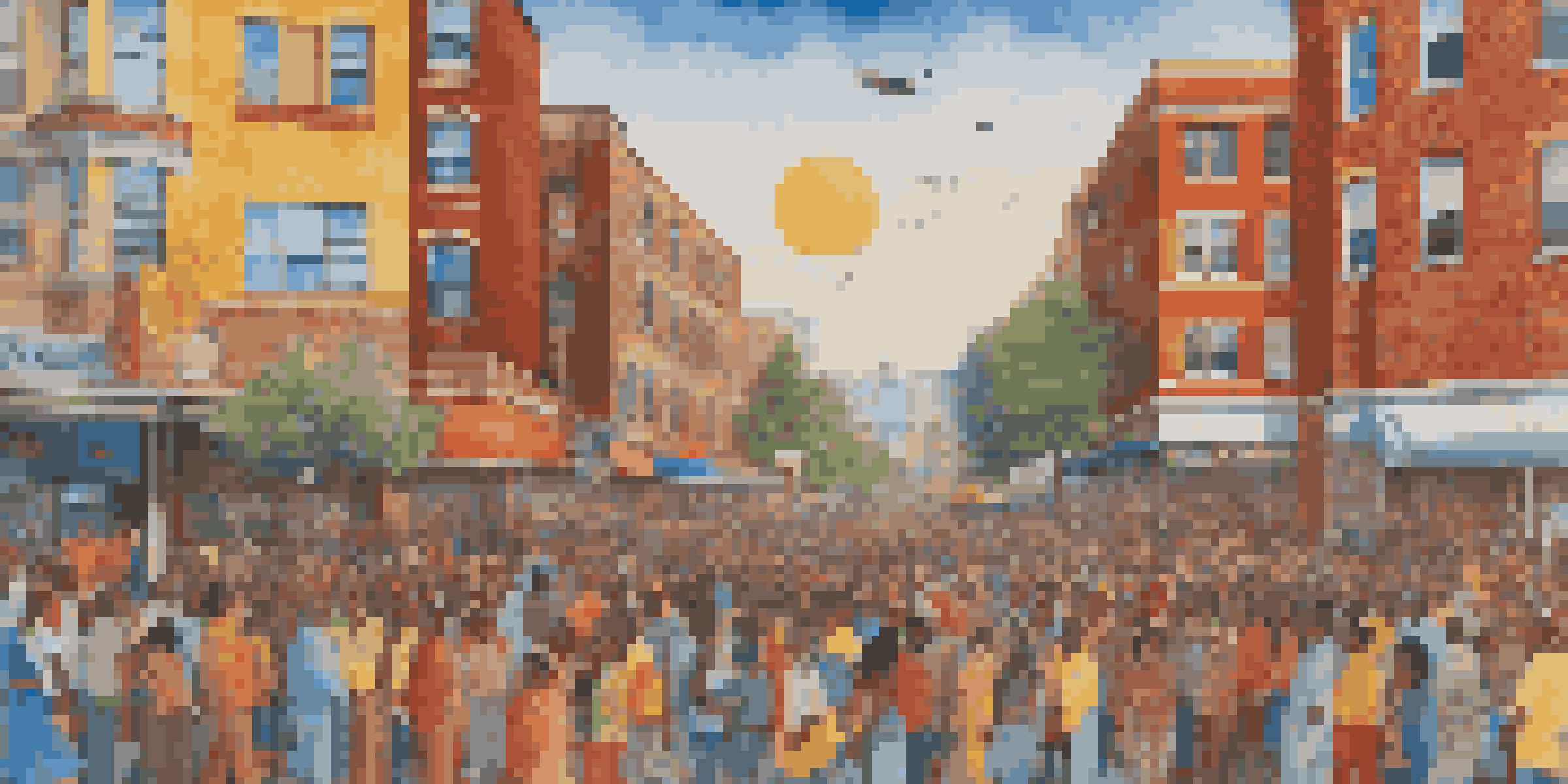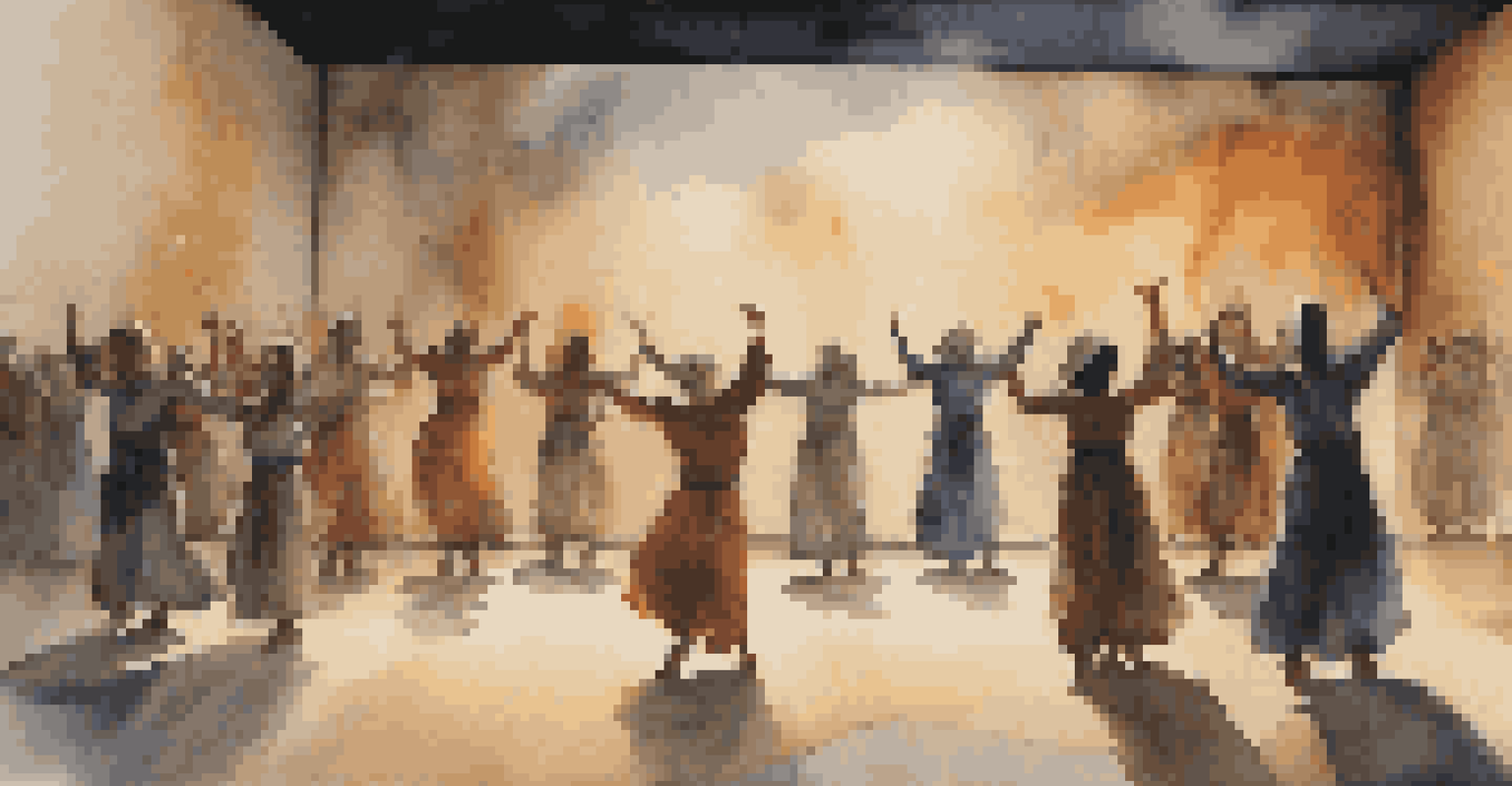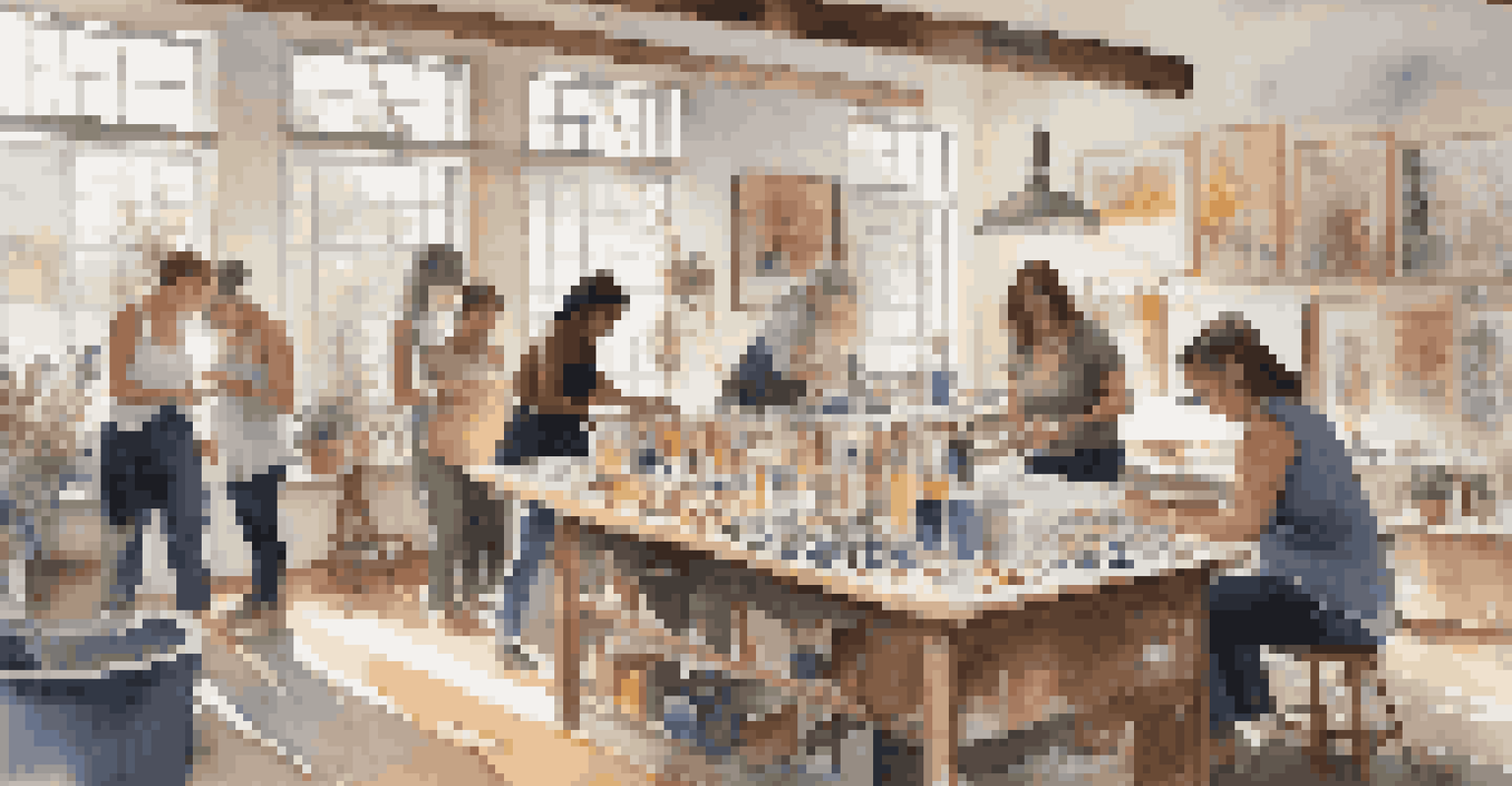The Role of Art in Remembering Displacement and Migration

Understanding Displacement and Migration Through Art
Displacement and migration are experiences that shape countless lives, often marked by loss and resilience. Art provides a unique lens through which we can explore these themes, allowing individuals to express their emotions and stories. Whether through painting, sculpture, or performance, artists capture the complexities of their journeys, making the invisible visible.
Art is a universal language that speaks to the heart of humanity.
For instance, a mural depicting the struggles of refugees can communicate the urgency of their plight while fostering empathy among viewers. This emotional connection is crucial, as it invites society to acknowledge the realities faced by displaced individuals. By translating personal narratives into visual forms, art becomes a bridge between different cultures and experiences.
Moreover, art can challenge stereotypes and misconceptions about migration, offering a more nuanced perspective. It encourages dialogue and understanding, reminding us that behind every statistic lies a human story. As we engage with these artistic expressions, we not only remember the past but also envision a future where migration is seen as a shared human experience.
Art as a Tool for Healing and Reflection
The act of creating art can be therapeutic for those who have experienced displacement. Engaging in artistic practices allows individuals to process their emotions, confront their traumas, and find solace in expression. This healing journey is vital, as it empowers artists to reclaim their narratives and find strength in vulnerability.

For example, workshops that encourage displaced individuals to share their stories through art can foster community and connection. Participants often find a sense of belonging as they collaborate and support one another in their creative endeavors. This collective healing can be transformative, turning pain into power and isolation into solidarity.
Art as a Voice for Displacement
Art serves as a powerful medium for expressing the complex emotions and stories of individuals experiencing displacement and migration.
Additionally, art can serve as a means of preserving cultural identity amidst the challenges of migration. By incorporating traditional elements into their work, artists honor their heritage while navigating new environments. This blend of old and new not only enriches their artistic expression but also reinforces the importance of cultural continuity in the face of change.
The Impact of Visual Arts on Public Awareness
Visual arts play a significant role in raising public awareness about displacement and migration. Exhibitions and installations can draw attention to critical issues, sparking conversations that might otherwise go unnoticed. When art enters public spaces, it invites diverse audiences to engage with the subject matter, often leading to increased empathy and understanding.
The artist's job is to be a witness to their time in history.
Take, for instance, the powerful installations that use everyday objects to symbolize the journeys of migrants. These visual metaphors can resonate deeply with viewers, allowing them to grasp the significance of the migration experience on a personal level. Such encounters can challenge preconceived notions and inspire action, whether through advocacy or support.
Moreover, social media has amplified the reach of these artistic expressions, allowing artists to share their work with a global audience. This digital platform creates opportunities for collaboration and dialogue, enabling stories of displacement to transcend geographical boundaries. Ultimately, the impact of visual arts in public awareness is profound, as it cultivates a more informed and compassionate society.
Literary Arts: Telling Stories of Migration
Literary arts, including poetry, novels, and essays, also play a crucial role in narrating the experiences of migration. Through the written word, authors can delve into the emotional landscapes of displaced individuals, offering readers a glimpse into their worlds. This storytelling not only preserves these narratives but also humanizes the often abstract concept of migration.
For example, novels that explore the immigrant experience can resonate with those who have faced similar challenges, creating a sense of shared understanding. Readers may find solace in the characters’ journeys, recognizing their own struggles in the pages. This connection fosters empathy and enriches the discourse around migration.
Healing Through Creative Expression
Engaging in artistic practices offers therapeutic benefits, helping displaced individuals process their experiences and build community.
Furthermore, literary arts often serve as a platform for marginalized voices, amplifying perspectives that might be overlooked. By prioritizing these narratives, authors challenge dominant narratives about migration, promoting a more inclusive dialogue. In this way, literature becomes a powerful tool for advocacy and change, encouraging society to listen and learn from those who have been displaced.
Performance Art: Bringing Migration Stories to Life
Performance art offers a dynamic and immersive way to convey the narratives of displacement. Through movement, theater, and spoken word, artists can embody the emotions and experiences associated with migration, creating a visceral connection with their audience. This form of art invites viewers to witness the stories unfold in real-time, evoking empathy and reflection.
For instance, a theater production that dramatizes the journey of refugees can leave a lasting impact on audiences, prompting them to engage with the subject matter on a deeper level. Performance art often breaks down barriers, making complex issues more accessible and relatable. It transforms the act of storytelling into a shared experience, fostering community and understanding.
Moreover, the ephemeral nature of performance art mirrors the transient experiences of many migrants. Each performance is unique, much like the individual stories behind displacement. This aspect not only highlights the fleeting nature of life but also emphasizes the importance of remembering and honoring these narratives through creative expression.
The Role of Community Art Projects in Memory Preservation
Community art projects are vital in preserving the memories of displacement and migration. These collaborations often bring together diverse groups, encouraging dialogue and collective storytelling. By involving community members in the creative process, these projects cultivate a sense of ownership and pride in their shared histories.
An example can be seen in community murals that depict local migration stories, creating a visual archive of experiences. Such projects not only beautify public spaces but also serve as reminders of the resilience and strength within migrant communities. They become landmarks of memory, inviting future generations to reflect on their heritage.
Raising Awareness with Visual Arts
Visual arts play a crucial role in increasing public awareness about migration issues, sparking conversations and fostering empathy.
Additionally, these art initiatives can empower marginalized voices, providing a platform for individuals to share their stories. By valuing these narratives, communities can foster a greater understanding of the complexities surrounding migration. Ultimately, community art projects play a crucial role in ensuring that the memories of displacement are honored and remembered.
Art's Future in Addressing Migration Challenges
As we look towards the future, the role of art in addressing migration challenges remains crucial. Artists are often at the forefront of social change, using their creativity to inspire action and provoke thought. By continuing to explore themes of displacement, they can contribute to a broader understanding of the issues at hand.
Moreover, new technologies and digital platforms are expanding the possibilities for artistic expression. Virtual reality experiences, for instance, can immerse audiences in the realities of migration, allowing them to engage with the subject matter in innovative ways. This evolution in art forms will likely enhance the impact of storytelling and memory preservation.

Additionally, collaboration between artists, activists, and organizations can amplify the voices of displaced individuals. By working together, they can create powerful campaigns that raise awareness and advocate for change. Ultimately, the future of art in addressing migration challenges holds great potential, as it continues to serve as a catalyst for understanding, healing, and connection.